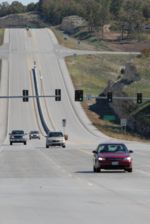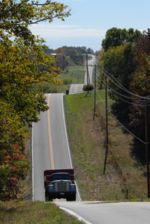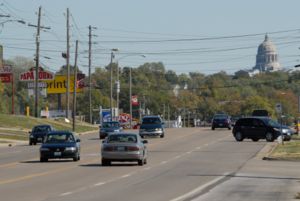Category:232 Facility Selection: Difference between revisions
m article construction |
updated per RR3736 |
||
| (11 intermediate revisions by one other user not shown) | |||
| Line 1: | Line 1: | ||
{|style="padding: 0.3em; margin-left:15px; border: | {|style="padding: 0.3em; margin-left:15px; border:2px solid #a9a9a9; text-align:center; font-size: 95%; background:#f5f5f5" width="240px" align="right" | ||
|-style="background:#f5f5f5" | |-style="background:#f5f5f5" | ||
|'''Figures''' | |'''Figures''' | ||
|- | |- | ||
|[[:Category:231 Typical Section Elements for Roadways|Typical Roadway Sections]] | |[[:Category:231 Typical Section Elements for Roadways|Typical Roadway Sections]] | ||
|- | |||
|'''Additional Resource''' | |||
|- | |||
|[http://teachamerica.com/cve/ Corridor Visualization Explorer], a high-level planning tool for managing corridors | |||
|} | |} | ||
The type of facility chosen must fulfill only the purpose and need of the corridor, no more and no less. The purpose and need of a highway corridor involves more than traffic volume alone. Refer to [[905.3_Transportation_Impact_Analysis#905.3.2.3_Determine_the_Project.E2.80.99s_Analytical_Context|EPG 905.3.2.3]] for a more thorough explanation of this facility selection process. Many different measures of effectiveness (MOE) can be considered depending upon site-specific conditions and concerns. Some common MOE include crash frequency, speed, travel time, delay, density, queue lengths, and throughput. The desired operational level of service (LOS) of the highway is a common factor used when selecting the facility type. | |||
The type of facility chosen must fulfill only the purpose and need of the corridor, no more and no less. | |||
'''Level of Service (LOS)''' | '''Level of Service (LOS)''' | ||
For both [ | The methodology for determining LOS and the thresholds for the various levels described below can be found in the ''Highway Capacity Manual''. | ||
For both [[media:144 Major Highway System 2022.pdf|major routes]] and minor routes (those which are not "major"), the type of facility will be based upon the desired LOS given the traffic projection of the corridor. Typically, a 20-year traffic forecast is used for the analysis. The six LOS grades are defined as: | |||
:* A - free flow | |||
[[image:232 Photo3 Freeway.jpg|right|150px|thumb|<center>'''Freeway'''</center>]] [[image:232 Photo2 Expressway.jpg|right|150px|thumb|<center>'''Expressway'''</center>]] [[image:232 Facility Selection rural.jpg|right|150px|thumb|<center>'''Rural 2-lane'''</center>]] | |||
:* B - reasonably free flow | |||
:* C - stable flow | |||
:* D - approaching unstable flow | |||
:* E - unstable flow | |||
:* F - forced or breakdown flow | |||
The Peak Hour LOS for the | The Peak Hour LOS for the traffic projection of a rural corridor should be D and its Off-Peak LOS should be C. The Peak Hour LOS for the traffic projection of an urban corridor should be E and its Off-Peak Hour LOS should be D. Planning Division will continue to identify the general types of facilities for statewide system continuity. | ||
The specific LOS of a facility is | The specific LOS of a facility is typically identified using traffic modeling software. In general, it is adequate for all routes in rural locations to accommodate the peak hour traffic projection at a LOS of D and off-peak traffic at a LOS of C. Similarly, it is adequate for all roads in urban or suburban locations to accommodate the peak hour traffic projection at a LOS of E, off-peak traffic at a LOS of D. Given these LOS targets, the designer will use the formulas given in the ''AASHTO Highway Capacity Manual'', Highway Capacity Software or other traffic modeling software to determine the appropriate facility type. | ||
Given these LOS targets, the designer will use the formulas given in the ''AASHTO Highway Capacity Manual'', Highway Capacity Software or other traffic modeling software to determine the appropriate facility type. | |||
'''System Continuity''' | '''System Continuity''' | ||
| Line 36: | Line 41: | ||
'''Access vs. Mobility''' | '''Access vs. Mobility''' | ||
In general, highways serve two purposes: providing mobility and access. All highway corridors require some aspect of both access and mobility, although the relationship between the two is indirectly proportional. As the level of mobility of a facility increases, | In general, highways serve two purposes: providing mobility and access. All highway corridors require some aspect of both access and mobility, although the relationship between the two is indirectly proportional. As the level of mobility of a facility increases, its ability to provide access decreases and vice versa. Great care must be taken to strike an operational balance between the two, based on the project purpose and need. Nationwide, a great deal of research has been done in the area of access management. MoDOT’s [[:category:940 Access Management|Access Management Guidelines]] (AMG) were developed by tailoring this policy to the specific needs of Missouri’s highway system. The AMG must be used to provide the proper level of balance for individual projects. | ||
'''Expressway vs. Freeway''' | '''Expressway vs. Freeway''' | ||
| Line 42: | Line 47: | ||
In most cases, an expressway should be designed wherever the designers’ calculations determine the need for a four-lane facility. Expressways are inherently safer than “head-to-head” facilities while allowing higher levels of access than freeways. The costs associated with expressways are also much lower given the lower number of interchanges required. | In most cases, an expressway should be designed wherever the designers’ calculations determine the need for a four-lane facility. Expressways are inherently safer than “head-to-head” facilities while allowing higher levels of access than freeways. The costs associated with expressways are also much lower given the lower number of interchanges required. | ||
{| align=" | {| align="right" width="320" border="4" | ||
|-style="background:#cccccc" | |-style="background:#cccccc" | ||
|'''[http://wwwi/design/files/Direction%20Major%20Minor%20Roads%2010-17-06.pdf MoDOT's pamphlet ''Direction and Expectations for Missouri's Major and Minor Roads'']''' | |'''[http://wwwi/design/files/Direction%20Major%20Minor%20Roads%2010-17-06.pdf MoDOT's pamphlet ''Direction and Expectations for Missouri's Major and Minor Roads'']''' | ||
| Line 48: | Line 53: | ||
Exceptions to this policy should be considered where safety and operational characteristics of the project dictate the need for a freeway. A freeway facility is mandated for the Interstate System. | Exceptions to this policy should be considered where safety and operational characteristics of the project dictate the need for a freeway. A freeway facility is mandated for the Interstate System. | ||
'''Two Way Left Turn Lanes''' | '''Two Way Left Turn Lanes''' | ||
[[image:232 Photo1 Access-Mobility.jpg|right|300px|thumb|<center>Two Way Left Turn Lane</center>]] | [[image:232 Photo1 Access-Mobility.jpg|right|300px|thumb|<center>'''Two-Way Left Turn Lane'''</center>]] | ||
| Line 62: | Line 64: | ||
At times, a poor LOS can be attributed to a lack of passing opportunities and vehicle’s time spent following slower vehicles. In these situations, the highway’s performance can be greatly increased by providing dedicated passing opportunities. While there are many ways to accomplish this, the improvement is generically referred to as a “[[232.2 Passing Lanes|passing lane]]”. The improvement can be as simple as the addition of a [[232.1 Climbing Lanes|climbing lane]] on a steep grade or as complex as a [[232.2 Passing Lanes#232.2.3.1 Alternative Configurations|"shared 4-lane" (also known as 2+1) roadway]] that provides a continuous third lane to offer alternating passing opportunity to either direction of travel. | At times, a poor LOS can be attributed to a lack of passing opportunities and vehicle’s time spent following slower vehicles. In these situations, the highway’s performance can be greatly increased by providing dedicated passing opportunities. While there are many ways to accomplish this, the improvement is generically referred to as a “[[232.2 Passing Lanes|passing lane]]”. The improvement can be as simple as the addition of a [[232.1 Climbing Lanes|climbing lane]] on a steep grade or as complex as a [[232.2 Passing Lanes#232.2.3.1 Alternative Configurations|"shared 4-lane" (also known as 2+1) roadway]] that provides a continuous third lane to offer alternating passing opportunity to either direction of travel. | ||
{|style="padding: 0.3em; margin-left:7px; border:1px solid #a9a9a9; text-align:center; font-size: 95%; background:#ffddcc" width="340px" align="right" | |||
|- | |||
|'''Truck Only and Passenger Vehicle Only Research''' | |||
|- | |||
|[https://spexternal.modot.mo.gov/sites/cm/CORDT/or10008.pdf Engineering Specifications for Construction of Truck Only and Passenger Vehicle Only Travelways - Phase 1, 2009] | |||
|- | |||
|[https://spexternal.modot.mo.gov/sites/cm/CORDT/cmr16-017.pdf Developing a System to Identify Passing and No Passing Zone Boundaries on Rural Two-Lane Highways, 2016] | |||
|- | |||
|'''See also:''' [https://www.modot.org/research-publications Research Publications] | |||
|} | |||
Latest revision as of 09:57, 26 July 2023
| Figures |
| Typical Roadway Sections |
| Additional Resource |
| Corridor Visualization Explorer, a high-level planning tool for managing corridors |
The type of facility chosen must fulfill only the purpose and need of the corridor, no more and no less. The purpose and need of a highway corridor involves more than traffic volume alone. Refer to EPG 905.3.2.3 for a more thorough explanation of this facility selection process. Many different measures of effectiveness (MOE) can be considered depending upon site-specific conditions and concerns. Some common MOE include crash frequency, speed, travel time, delay, density, queue lengths, and throughput. The desired operational level of service (LOS) of the highway is a common factor used when selecting the facility type.
Level of Service (LOS)
The methodology for determining LOS and the thresholds for the various levels described below can be found in the Highway Capacity Manual.
For both major routes and minor routes (those which are not "major"), the type of facility will be based upon the desired LOS given the traffic projection of the corridor. Typically, a 20-year traffic forecast is used for the analysis. The six LOS grades are defined as:
- A - free flow



- B - reasonably free flow
- C - stable flow
- D - approaching unstable flow
- E - unstable flow
- F - forced or breakdown flow
The Peak Hour LOS for the traffic projection of a rural corridor should be D and its Off-Peak LOS should be C. The Peak Hour LOS for the traffic projection of an urban corridor should be E and its Off-Peak Hour LOS should be D. Planning Division will continue to identify the general types of facilities for statewide system continuity.
The specific LOS of a facility is typically identified using traffic modeling software. In general, it is adequate for all routes in rural locations to accommodate the peak hour traffic projection at a LOS of D and off-peak traffic at a LOS of C. Similarly, it is adequate for all roads in urban or suburban locations to accommodate the peak hour traffic projection at a LOS of E, off-peak traffic at a LOS of D. Given these LOS targets, the designer will use the formulas given in the AASHTO Highway Capacity Manual, Highway Capacity Software or other traffic modeling software to determine the appropriate facility type.
System Continuity
Some highway corridors in the state have a desired facility type for the entire corridor that has already been established by MoDOT’s Planning Division. This has been done to establish general system continuity within the state. For this reason, projects that lie within such corridors should conform to the established facility type, regardless of localized LOS computation.
Access vs. Mobility
In general, highways serve two purposes: providing mobility and access. All highway corridors require some aspect of both access and mobility, although the relationship between the two is indirectly proportional. As the level of mobility of a facility increases, its ability to provide access decreases and vice versa. Great care must be taken to strike an operational balance between the two, based on the project purpose and need. Nationwide, a great deal of research has been done in the area of access management. MoDOT’s Access Management Guidelines (AMG) were developed by tailoring this policy to the specific needs of Missouri’s highway system. The AMG must be used to provide the proper level of balance for individual projects.
Expressway vs. Freeway
In most cases, an expressway should be designed wherever the designers’ calculations determine the need for a four-lane facility. Expressways are inherently safer than “head-to-head” facilities while allowing higher levels of access than freeways. The costs associated with expressways are also much lower given the lower number of interchanges required.
| MoDOT's pamphlet Direction and Expectations for Missouri's Major and Minor Roads |
Exceptions to this policy should be considered where safety and operational characteristics of the project dictate the need for a freeway. A freeway facility is mandated for the Interstate System.
Two Way Left Turn Lanes

In the past, two way left turn lanes (TWLTL) have been viewed as operationally deficient. Within the context of a practical solution, however, this arrangement may provide legitimate access on projects and may be considered in certain locations. Two-way left-turn lanes (TWLTL) are permissible where practical.
Passing Lanes
At times, a poor LOS can be attributed to a lack of passing opportunities and vehicle’s time spent following slower vehicles. In these situations, the highway’s performance can be greatly increased by providing dedicated passing opportunities. While there are many ways to accomplish this, the improvement is generically referred to as a “passing lane”. The improvement can be as simple as the addition of a climbing lane on a steep grade or as complex as a "shared 4-lane" (also known as 2+1) roadway that provides a continuous third lane to offer alternating passing opportunity to either direction of travel.
| Truck Only and Passenger Vehicle Only Research |
| Engineering Specifications for Construction of Truck Only and Passenger Vehicle Only Travelways - Phase 1, 2009 |
| Developing a System to Identify Passing and No Passing Zone Boundaries on Rural Two-Lane Highways, 2016 |
| See also: Research Publications |
Articles in "232 Facility Selection"
The following 5 pages are in this category, out of 5 total.